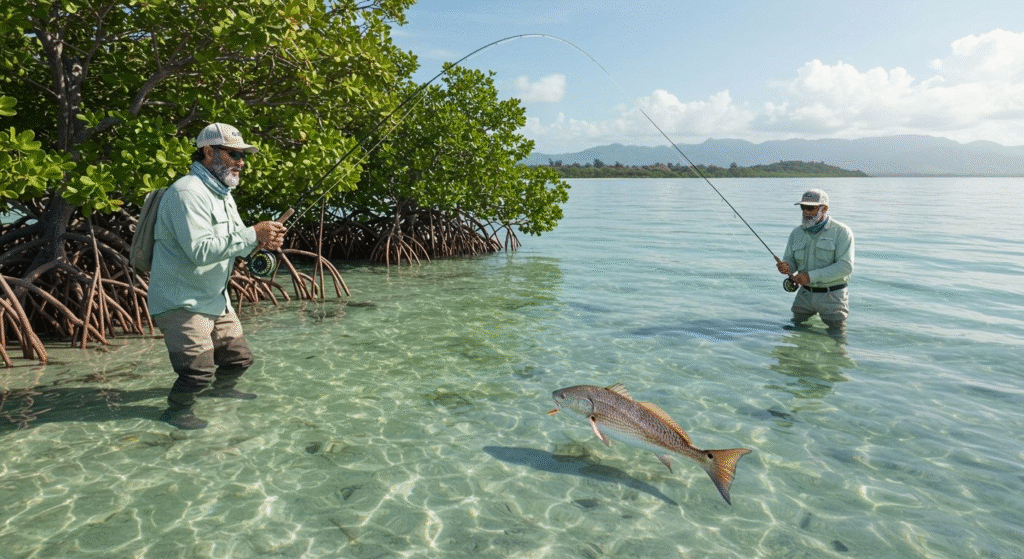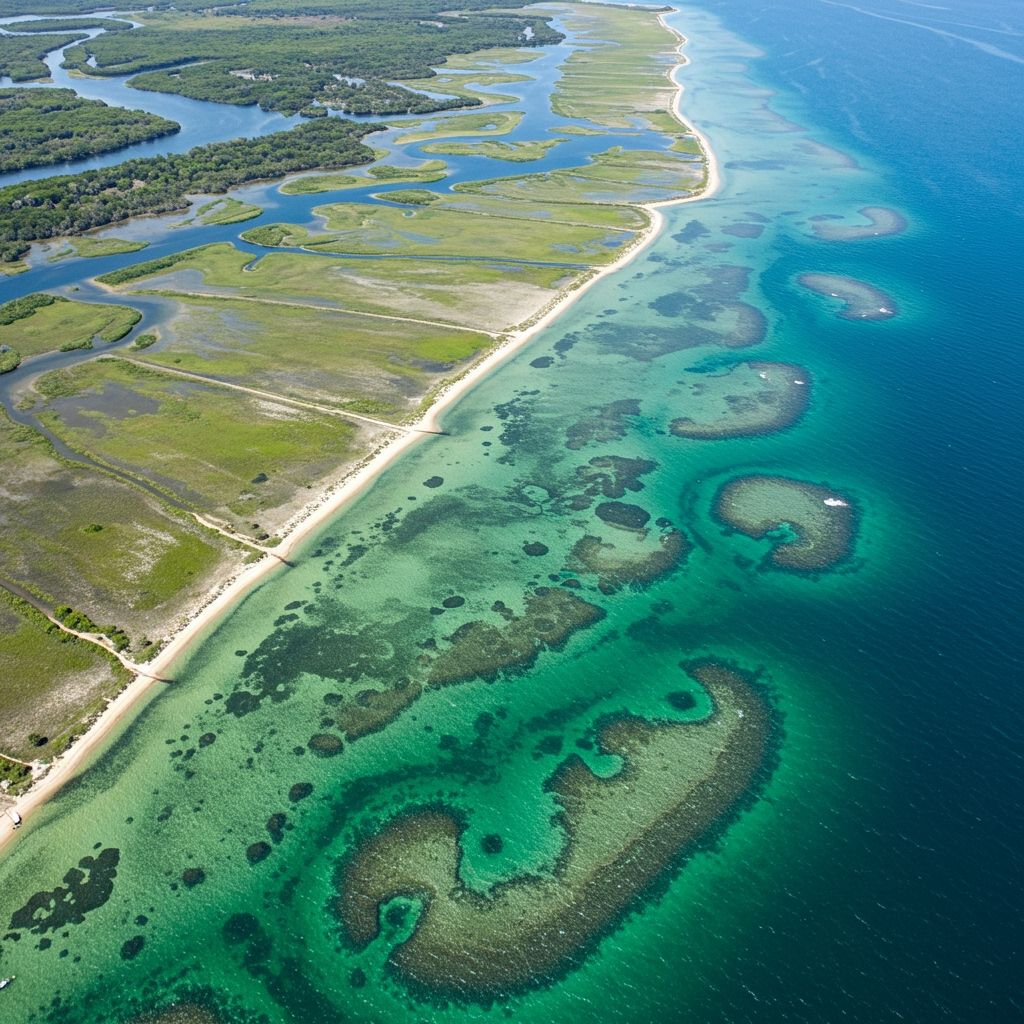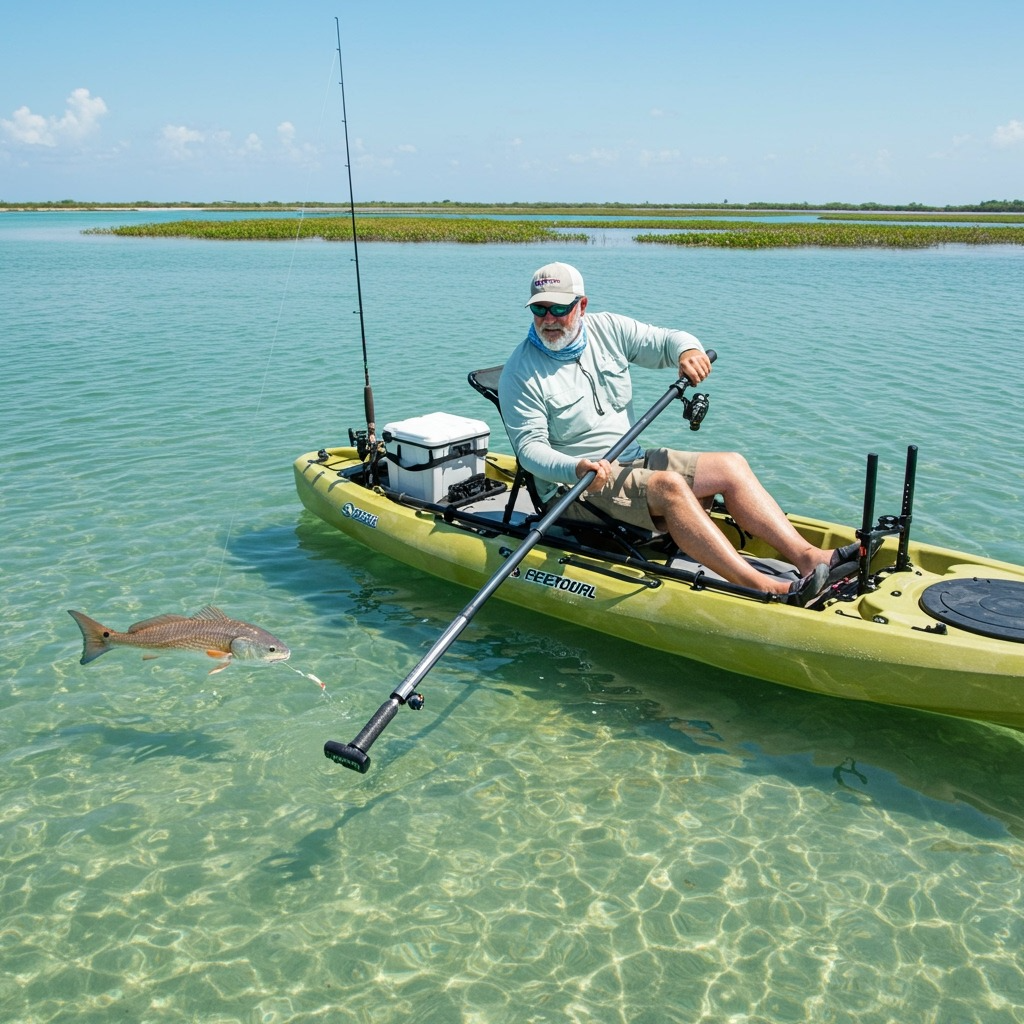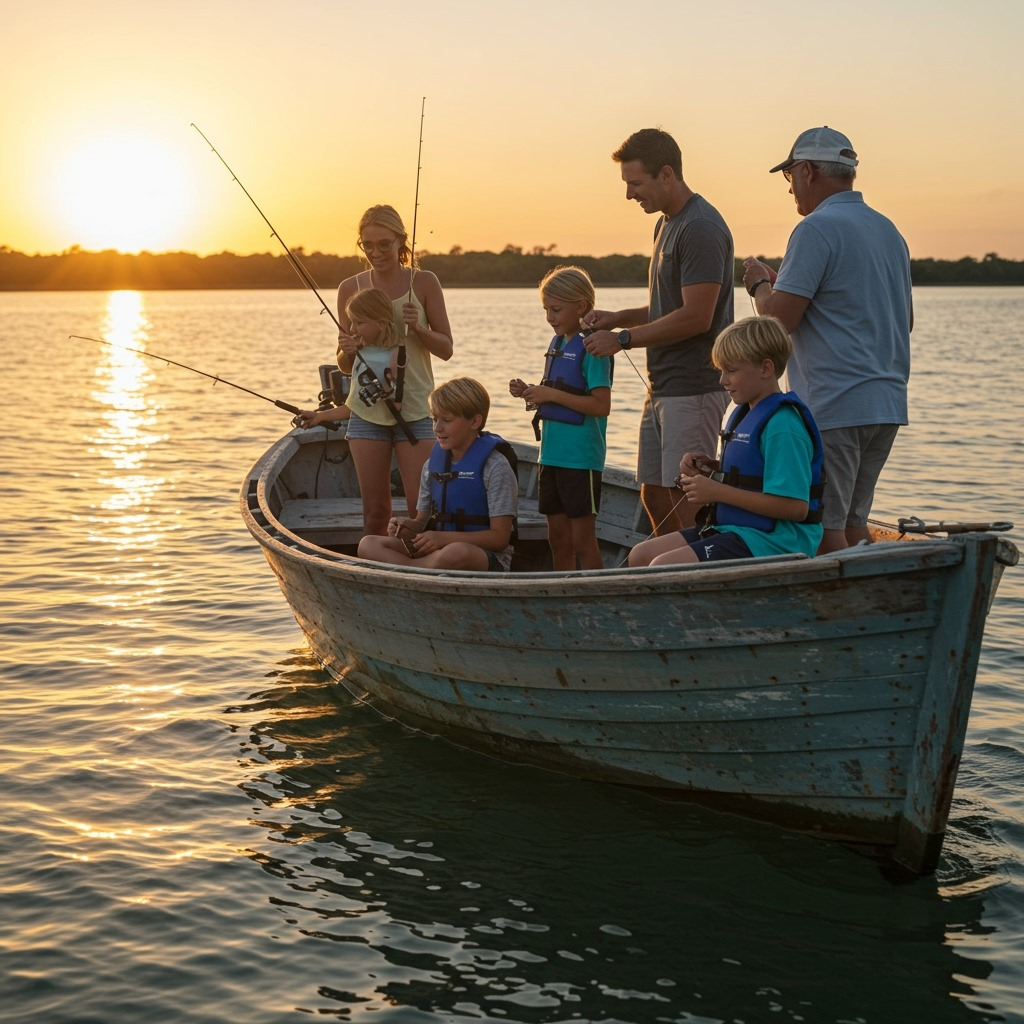Standing knee-deep in crystal-clear water off the Florida coast, watching a massive redfish cruise through the shallows just 20 feet away, I finally understood what the fuss was about. Inshore fishing wasn’t just “easier” than offshore—it was its own incredible adventure, full of sight-fishing thrills, diverse species, and accessible action that didn’t require a 40-foot boat or a captain’s license.
That first inshore trip hooked me completely. The combination of technical skill, visual excitement, and consistent action made it clear why millions of anglers choose shallow saltwater over the deep blue. Whether you’re tired of rough seas, looking for family-friendly fishing, or simply want to try something new, inshore fishing offers some of the most rewarding angling experiences available.
Here’s everything you need to know about inshore fishing, from basic definitions to advanced techniques that will have you catching fish in the shallows like a seasoned pro.
What Exactly Is Inshore Fishing?
Inshore fishing refers to saltwater angling that takes place in shallow waters, typically within a few miles of the coastline and in depths of 30 feet or less. Unlike offshore fishing that requires venturing into deep ocean waters, inshore fishing happens in protected bays, estuaries, flats, and nearshore waters where you can often see the bottom.
The beauty of inshore fishing lies in its accessibility. You can fish from small boats, kayaks, or even wade right from the shore. The calmer waters make it perfect for beginners, families, and anyone who prefers staying close to land while still experiencing incredible saltwater fishing action.
Key Characteristics of Inshore Waters
- Depth: Generally 3-30 feet deep, though some consider anything under 100 feet as inshore
- Distance: Usually within 1-9 miles of shore, often within sight of land
- Water Type: Saltwater, brackish water, or tidal areas where fresh and salt water mix
- Environment: Protected bays, estuaries, grass flats, mangrove shorelines, and tidal creeks
Where Inshore Fishing Takes Place
Prime Inshore Habitats
Grass Flats
Shallow areas covered with seagrass that provide food and shelter for countless species. These underwater meadows are prime hunting grounds for speckled trout, redfish, and flounder.
Mangrove Shorelines
Twisted mangrove roots create perfect ambush points for snook, tarpon, and redfish. The structure provides cover while the roots filter nutrients that attract baitfish.
Oyster Bars and Shell Banks
These natural structures concentrate baitfish and provide hard bottom for species like sheepshead, black drum, and redfish to feed on crustaceans and mollusks.
Tidal Creeks and Channels
Moving water brings food and oxygen, making creeks and channels productive spots during tide changes. These areas often hold flounder, trout, and various species moving with the tides.
Sandy Flats and Beaches
Open sandy areas near deeper water provide feeding opportunities for cruising species like permit, bonefish, and various sharks.
Understanding different fishing techniques becomes crucial when targeting these varied inshore environments.
Popular Inshore Fish Species
The Big Four of Inshore Fishing
Redfish (Red Drum)
These copper-colored fighters are inshore favorites, known for powerful runs and willingness to take both live and artificial baits. They cruise shallow flats and hang around structure, making them perfect targets for sight fishing.
Speckled Trout (Spotted Seatrout)
Beautiful fish with distinctive spots, trout are excellent table fare and fight well on light tackle. They prefer grass flats and drop-offs, often feeding in schools during cooler months.
Snook
Aggressive predators with distinctive black lateral lines, snook ambush prey around mangroves, docks, and bridges. They’re known for explosive strikes and acrobatic fights.
Flounder
Flatfish that lie camouflaged on sandy or muddy bottoms, flounder are excellent eating and fun to catch. They’re perfect targets for drift fishing and bottom bouncing techniques.
Regional Variations
- Gulf Coast: Redfish, speckled trout, flounder, Spanish mackerel, king mackerel
- Atlantic Coast: Striped bass, flounder, bluefish, weakfish, black drum
- Pacific Coast: Halibut, lingcod, rockfish, salmon (in certain areas)
- Tropical Waters: Bonefish, permit, tarpon, barracuda, various snappers
Inshore vs Offshore: Key Differences
| Aspect | Inshore | Offshore |
| Water Depth | 3-30 feet | 100+ feet |
| Distance from Shore | 1-9 miles | 20+ miles |
| Boat Size | Small boats, kayaks, wade fishing | Larger boats with advanced equipment |
| Trip Duration | 4-6 hours | 8-12+ hours |
| Tackle Weight | Light to medium | Heavy duty |
| Seasickness Risk | Low (calmer waters) | Higher (rough seas) |
| Cost | More affordable | More expensive |
| Fish Size | Moderate | Larger species |
Essential Inshore Fishing Techniques
Sight Fishing
The most exciting aspect of inshore fishing is often being able to see your target. Polarized sunglasses become essential gear as you scan shallow flats for cruising fish, tailing redfish, or schools of trout.
Sight Fishing Tips:
- Move slowly and quietly to avoid spooking fish
- Cast ahead of moving fish, not directly at them
- Use natural-colored lures that match local baitfish
- Learn to read fish behavior and feeding patterns
Live Bait Fishing
Live bait remains one of the most effective inshore techniques. Popular choices include shrimp, mullet, pinfish, and small crabs, depending on your target species and location.
Live Bait Strategies:
- Match bait size to target species
- Use circle hooks to reduce deep hooking
- Fish live bait near structure and current breaks
- Keep bait lively with proper aeration
Artificial Lure Fishing
Artificial lures allow you to cover more water and target active fish effectively. Popular inshore lures include soft plastics, topwater plugs, spoons, and jigs.
Lure Selection Guidelines:
- Soft plastics: Versatile for all depths and conditions
- Topwater: Early morning and evening surface action
- Spoons: Great for schooling fish and current areas
- Jigs: Excellent for bottom fishing and structure
For those interested in expanding their fishing skills, learning about surf fishing basics provides additional techniques that work well in inshore environments.
Inshore Fishing Gear Essentials
Rod and Reel Selection
Light to Medium Spinning Tackle
Most inshore fishing situations call for 6-7 foot medium-light to medium spinning rods paired with 2500-4000 size reels. This combination provides the sensitivity needed for detecting subtle bites while having enough backbone to handle quality fish.
Baitcasting Gear
For larger species or heavy cover situations, baitcasting reels offer better control and power. Choose reels with smooth drags and corrosion-resistant construction for saltwater use.
Line Choices
Braided Line
Many inshore anglers prefer braided line for its thin diameter, lack of stretch, and superior sensitivity. 10-20 lb braid works well for most inshore situations.
Fluorocarbon Leaders
Always use fluorocarbon leaders in clear water situations. The near-invisibility gives you a significant advantage with wary fish. 15-30 lb test leaders handle most inshore species.
Understanding different line types helps you make the right choice for specific inshore conditions.
Essential Tackle
- Hooks: Circle hooks for live bait, J-hooks for artificial lures
- Weights: Split shot, egg sinkers, and jig heads in various sizes
- Swivels and Snaps: For quick lure changes and preventing line twist
- Pliers: Needle-nose pliers for hook removal and crimping
- Net: Landing net for safely handling fish
Reading Inshore Waters
Understanding Tides
Tides drive inshore fishing success more than any other factor. Moving water brings food, oxygen, and positions fish in predictable locations.
Tide Fishing Strategy:
- Incoming Tide: Fish move onto flats and into shallow areas to feed
- High Tide: Fish spread out over large areas, focus on structure
- Outgoing Tide: Fish concentrate in channels and deeper holes
- Low Tide: Fish hold in deeper water, creeks, and channels
Structure Identification
Learning to read water and identify fish-holding structure is crucial for consistent inshore success.
Key Structure Elements:
- Drop-offs and depth changes
- Points and underwater humps
- Docks, pilings, and man-made structure
- Natural structure like oyster bars and rock piles
- Current breaks and eddies
Water Conditions
- Water Clarity: Clear water requires stealthier approaches and natural presentations
- Water Temperature: Fish activity and location change with temperature
- Current: Moving water activates fish and concentrates baitfish
- Wind: Can push baitfish and affect fish positioning
Seasonal Inshore Fishing Patterns
Spring Inshore Fishing
Spring brings warming water temperatures and increased fish activity. Many species move into shallow areas to spawn, creating excellent fishing opportunities.
Spring Highlights:
- Pre-spawn feeding activity
- Fish moving into shallow areas
- Increased baitfish activity
- Variable weather patterns
Summer Inshore Fishing
Summer provides the most consistent inshore fishing with warm water temperatures and active fish. Early morning and evening fishing often produces the best results.
Summer Strategies:
- Fish early and late to avoid heat
- Target deeper water during midday
- Use topwater lures during low-light periods
- Focus on current and structure for active fish
Fall Inshore Fishing
Fall fishing can be spectacular as fish feed heavily before winter. Cooler temperatures bring fish back to shallow areas and increase activity levels.
Fall Advantages:
- Increased fish activity
- Larger schools of baitfish
- Comfortable fishing conditions
- Less angling pressure
Winter Inshore Fishing
Winter fishing requires adapting to colder temperatures and less active fish. Focus on deeper water and slower presentations during the coldest months.
Winter Adjustments:
- Fish deeper water and warmer areas
- Use slower retrieves and smaller baits
- Target sunny days for best activity
- Focus on structure and hard bottom areas
For extended fishing trips, understanding camping fundamentals helps you stay comfortable during multi-day inshore adventures.
Safety Considerations for Inshore Fishing
Navigation and Weather
Even though inshore waters are protected, weather and navigation hazards still exist. Always check weather forecasts and understand local conditions before heading out.
Safety Essentials:
- Check weather and marine forecasts
- File a float plan with someone reliable
- Carry emergency communication devices
- Know your local waters and hazards
Equipment Safety
- Personal Flotation Devices: Always wear or have easily accessible PFDs
- First Aid Kit: Include basic medical supplies and emergency medications
- Sun Protection: Sunscreen, hats, and protective clothing
- Hydration: Bring plenty of fresh water, especially during summer
Tidal Awareness
Understanding tidal movements is crucial for safe inshore fishing. Extreme low tides can strand boats, while strong tidal currents can create dangerous conditions.
Conservation and Ethics
Catch and Release Practices
Many inshore species benefit from catch and release practices to maintain healthy populations for future generations.
Proper Release Techniques:
- Use circle hooks to reduce injury
- Handle fish with wet hands or gloves
- Support fish properly during photos
- Release fish quickly in appropriate water depth
Regulations and Limits
Always check current fishing regulations for your area, including size limits, bag limits, and seasonal closures. Many popular inshore species have specific regulations designed to protect spawning populations.
Stay Legal:
- Carry a current fishing license
- Know size and bag limits for target species
- Understand seasonal closures and restricted areas
- Use proper measurement techniques
Getting Started with Inshore Fishing
Your First Inshore Trip
- Choose the Right Location: Start with easily accessible areas like public boat ramps or fishing piers
- Time It Right: Plan trips around moving tides for best success
- Start Simple: Use basic tackle and proven techniques before advancing to specialized gear
- Consider a Guide: A good guide can accelerate your learning curve significantly
Building Skills
- Practice Casting: Accurate casting is crucial for inshore success
- Learn to Read Water: Develop skills in identifying productive water
- Understand Fish Behavior: Study how different species react to tides, weather, and seasons
- Network with Local Anglers: Join fishing clubs or online communities for local knowledge
Equipment Progression
Start with basic gear and upgrade as your skills and interests develop. You don’t need expensive equipment to be successful, but quality gear makes the experience more enjoyable.
Advanced Inshore Techniques
Fly Fishing in the Shallows
Fly fishing adds an exciting dimension to inshore angling, particularly for sight fishing situations. The quiet presentation and precise casting make it ideal for spooky fish in shallow water.
Light Tackle Challenges
Using ultralight tackle increases the challenge and excitement of inshore fishing while requiring more skill and patience from the angler.
Technology Integration
Modern electronics like fish finders, GPS units, and smartphone apps can enhance inshore fishing success when used properly.
FAQ: Inshore Fishing Essentials
What’s the difference between inshore and offshore fishing?
Inshore fishing takes place in shallow waters (typically under 30 feet) within a few miles of shore, while offshore fishing occurs in deep water, usually 20+ miles from land. Inshore fishing uses lighter tackle and targets different species.
Do I need a big boat for inshore fishing?
No, inshore fishing can be done from small boats, kayaks, or even by wading. Many successful inshore anglers use 14-20 foot boats or fish from kayaks and shallow-water skiffs.
What’s the best tide for inshore fishing?
Moving tides (incoming or outgoing) are generally best for inshore fishing as they position fish in predictable locations and activate feeding behavior. The specific best tide varies by location and species.
Can beginners be successful at inshore fishing?
Absolutely! Inshore fishing is often easier for beginners than offshore fishing due to calmer conditions, lighter tackle, and more predictable fish behavior. Many guides specialize in teaching inshore techniques.
What’s the most important skill for inshore fishing?
Learning to read water and understand how tides, structure, and weather affect fish behavior is the most important skill. This knowledge helps you find fish consistently in different conditions.
Ready to experience the excitement of inshore fishing? Start with basic gear, choose accessible locations, and focus on learning to read the water. The combination of sight fishing thrills, diverse species, and accessible action makes inshore fishing one of the most rewarding forms of angling available.
Whether you’re targeting redfish on shallow flats, casting for snook around mangroves, or drifting for flounder over sandy bottom, inshore fishing offers endless opportunities for adventure and success. Get out there and discover why millions of anglers choose the shallows over the deep blue.
External Resources:
- NOAA Tide Predictions for accurate tide information
- Take Me Fishing: Saltwater Basics for additional saltwater techniques
More fishing wisdom on RichardsDiary:
The shallows are calling—grab your rod and discover the incredible world of inshore fishing!





